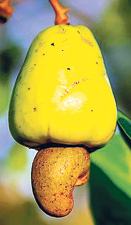The ripe kaju puhulam (cashew fruit) together with Avurudu symbols such as the koha and erabadu reminds us of the April festive season. The ripe red, orange or yellow cashew fruits nicely bundled together using an iratuwa (coconut midrib) were a common delicacy during the season decades ago. Now one wonders how many of the younger generation would have ever tasted kaju puhulam. Most village gardens in earlier days had one or two kaju trees, but no more.
"The cashew fruit, also known as cashew apple, has disappeared from the market. It is sad that the younger generation today is losing touch with this fruit which was in abundance when we were children," says Dr. Siril Wijesundara, Director of the Department of Botanical Gardens.
He recalls a traditional Avurudu game played using shelled cashew nuts known as Vala kaju gaseema. A small hollow is made in the sand and a player has to try to put his cashews in it or hit others afterward. "These traditional games are fast disappearing. So are the trees bearing the fruit," he says.
Dr. Wijesundara has a scientific explanation for the odd shape of the cashew fruit. "In fact, the puhulama or the cashew apple is a false fruit that is known as a pseudocarp or an accessory fruit. It is a modified fruit stalk (fruit pedicel).
"The real fruit of the cashew is the kidney shaped drupe hanging below the puhulama which has a single seed enclosed in a hard layer. You can clearly see this difference in a week-old cashew fruit with a large nut with accessory fruit only as a thin twig. But this stem gets fleshy and becomes very large when the fruit matures."
The ripe cashew apple can grow to about six cm. It is juicy and tastes sweet. While eating the fruit, one should be careful not to let the juice fall on the clothes. The fruit also attracts birds, squirrels and bats, which help to disperse the seeds around. Dr. Wijesundara says the cashew apple is rich in vitamin A and C — about 150-400 mg per 100 gram of fresh fruit. “This is about five times that in orange juice.”
Though the cashew apple is rare in the market, the cashew nut is still popular largely because of its culinary value. The seed is enclosed by a strong double shell containing an allergenic phenolic resin and anacardic acid. It also has a skin irritant that should be removed carefully.
Some experts point out that the main threat for the tree comes from two main pests — tea mosquito bug and stem borer, for which the Wayamba University's Agriculture and Plantation Management faculty has discovered methods of biological control.
"Red-ants commonly known as dimiya can be used to fight these bugs. Red ants feed on these bugs, and keep the cashew trees clean," says Prof. S.J.B.A. Jayasekera who carried out a study on the use of red ants as an eco-friendly pest controlling mechanism. He recommends this method to people who want to keep their cashew trees healthy.
The Sri Lanka Cashew Corporation has plans to popularize the cashew as an economic crop. Commercial cashew plantations in Sri Lanka cover about 100,000 acres with the Cashew Corporation accounting for more than 20,000 acres. The Corporation's Plantation Manager, G.D. Surendra, says more cashew plantations will be set up in the North and East because the soil and the climate suits the crop.
He says the corporation together with the Wayamba University is introducing high-yield varieties to encourage cashew growers.
"We have introduced six cashew varieties based on our common research," says Prof. Jayasekera who advises people to plant grafted or budded cashew plants as they will have the same characteristics as the mother plants. The university with the corporation has set up six seed gardens to meet the demand in a few years.
Prof. Jayasekera also says many useful parts of the cashew are wasted or underutilized. "Cashew oil can be extracted from the shell, which is usually thrown away. The oil is used in countries like China to reduce brake fade and brake lining wear. It is also used as wood preservation substance to prevent termite attacks.
Can't the cashew apple be used more productively? As an experiment, the Cashew Corporation has begun brewing wine from cashew apples. Nicely packaged, this product is available only at the Cashew Corporation outlet in Kollupititya. |


